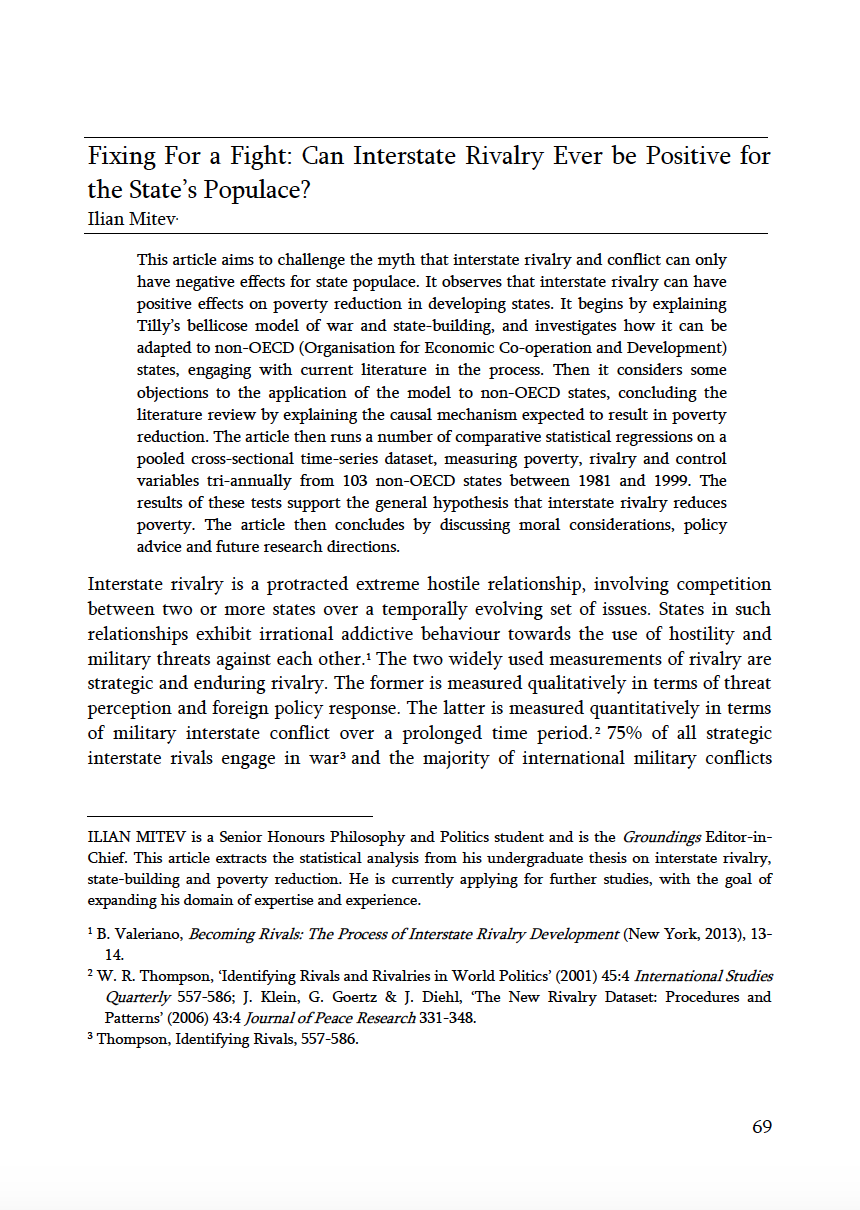Fixing For a Fight
Can Interstate Rivalry Ever be Positive for the State’s Populace?
DOI:
https://doi.org/10.36399/GroundingsUG.8.209Keywords:
Interstate Rivalry, Conflict, Tilly, State-building, Poverty, non-OECD, Critical reviewAbstract
This article aims to challenge the myth that interstate rivalry and conflict can only have negative effects for state populace. It observes that interstate rivalry can have positive effects on poverty reduction in developing states. It begins by explaining Tilly’s bellicose model of war and state-building, and investigates how it can be adapted to non-OECD (Organisation for Economic Co-operation and Development) states, engaging with current literature in the process. Then it considers some objections to the application of the model to non-OECD states, concluding the literature review by explaining the causal mechanism expected to result in poverty reduction. The article then runs a number of comparative statistical regressions on a pooled cross-sectional time-series dataset, measuring poverty, rivalry and control variables tri-annually from 103 non-OECD states between 1981 and 1999. The results of these tests support the general hypothesis that interstate rivalry reduces poverty. The article then concludes by discussing moral considerations, policy advice and future research directions.
References
M. Ayoob, The Third World Security Predicament: State Making, Regional Conflict, and the International System (Colorado, 1995).
M. A. Centeno, Blood and Debt: War and the Nation-State in Latin America (USA, 2002).
T. Ertman, Birth of the Leviathan: Building States and Regimes in Medieval and Early Modern Europe (USA, 1997).
J. Herbst, States and Power in Africa: Comparative Lessons in Authority and Control (USA, 2000).
K. Rasler & W. R. Thompson, ‘War Making and State Making: How and Where Does it Fit into a Bigger Picture?’ in J. Vasquez (ed.), What do we Know About War?, 2nd Edition (USA, 2012), 237-255.
C. Tilly, ‘War Making and State Making as Organized Crime.’ in P. Evans, D. Rueschemeyer & T. Skocpol (eds.), Bringing the State Back in (Cambridge, 1985).
C. Tilly, Coercion, Capital, and European States, AD 990-1992 (USA, 1992).
B. Valeriano, Becoming Rivals: The Process of Interstate Rivalry Development (New York, 2013).
J. Vasquez, The War Puzzle (Cambridge, 1993).
E. Alvi & A. Senbeta, ‘Does Foreign Aid Reduce Poverty?’ (2012) 24:8 Journal of International Development 955-976.
N. Beck & J. N. Katz, ’What to Do (And Not to Do) With Time-Series Cross-Section Data’ (1995) 89:3 American Political Science Review 634–647.
T. Besley & R. Burgess, ’Halving global poverty’ (2003) 17:3 The Journal of Economic Perspectives 3–22.
A. Goudie & P. Ladd, ‘Economic growth, poverty and inequality’ (1999) 11:2 Journal of International Development 177-195.
C-N. Kang & B. Valeriano, ‘Can an Interstate Rivalry Be Positive?’ International Studies Association Annual Meeting.
L. Lu & C. Thies, ‘War, Rivalry, and State Building in the Middle East’ (2013) 66:2 Political Research Quarterly 239-253.
P. Rudloff, J. M. Scott & T. Blew, ‘Countering adversaries and cultivating friends: Indirect rivalry factors and the allocation of US foreign aid’ (2013) 48:3 Cooperation and Conflict 401-423.
S. Sample, B. Valeriano & C-N. Kang, ‘The Societal Determinants and Impact of Military Spending Patterns’ (2013) 41 Political and Military Sociology –Annual Review 109-135.
D. Sobek & C. Thies, ‘War, Economic Development, and Political Development in the Contemporary International System’ (2010) 54:1 International Studies Quarterly 267-287.
C. Thies, ‘Political Violence and State Building in Central America’ (2006) 39:10 Comparative Political Studies 1263-1282.
C. Thies, ‘State Building, Interstate and Intrastate Rivalry: A Study of Post-Colonial Developing Country Extractive Efforts, 1975-2000’ (2004) 48:1 International Studies Quarterly 53-72.
C. Thies, ‘The Political Economy of State Building in Sub-Saharan Africa’ (2007) 69:3 The Journal of Politics 716-731.
C. Thies, ‘War, Rivalry, and State Building in Latin America’ (2005) 49:3 American Journal of Political Science 451-465.
‘Country and Lending Groups’, World Bank. Available: <http://data.worldbank.org/about/country-and-lending-groups> [Accessed 16.01.2015].
‘High-income OECD’, World Bank. Available: <http://data.worldbank.org/income-level/OECD> [Accessed 20.01.2015].
‘panelAR: Estimation of Linear AR(1) Panel Data Models with Cross-Sectional Heteroskedasticity and/or Correlation’, K. Kashin. Available: <http://cran.r-project.org/web/packages/panelAR/index.html> [Accessed 12.01.2015].
J. Klein, G. Goertz & J. Diehl, ‘The New Rivalry Dataset: Procedures and Patterns’ (2006) 43(4), Journal of Peace Research, 331-348.
W. R. Thompson, ‘Identifying Rivals and Rivalries in World Politics’ (2001) 45:4 International Studies Quarterly 557-586.
‘PovcalNet: the on-line tool for poverty measurement developed by the Development Research Group of the World Bank’ World Bank. Available: <http://iresearch.worldbank.org/PovcalNet/index.htm> [Accessed 12.12.2014].
‘World Development Indicators’, World Bank. Available: <http://data.worldbank.org/data-catalog/world-development-indicators> [Accessed 12.12.2014].

Downloads
Published
Issue
Section
License
Copyright (c) 2015 Ilian Mitev

This work is licensed under a Creative Commons Attribution 4.0 International License.
The CC BY 4.0 license is a Creative Commons license. This is a non-copyleft free license that is good for art and entertainment works, and educational works. It is compatible with all versions of the GNU GPL; however, like all CC licenses, it should not be used on software. People are free to: Share — copy and redistribute the material in any medium or format; Adapt — remix, transform, and build upon the material for any purpose, even commercially. The licensor cannot revoke these freedoms as long as you follow the license terms. But they must conform to the following terms: Attribution — You must give appropriate credit, provide a link to the license, and indicate if changes were made. You may do so in any reasonable manner, but not in any way that suggests the licensor endorses you or your use. No additional restrictions — You may not apply legal terms or technological measures that legally restrict others from doing anything the license permits.
Please check individual article PDF copies to see if any additional restrictions apply.







